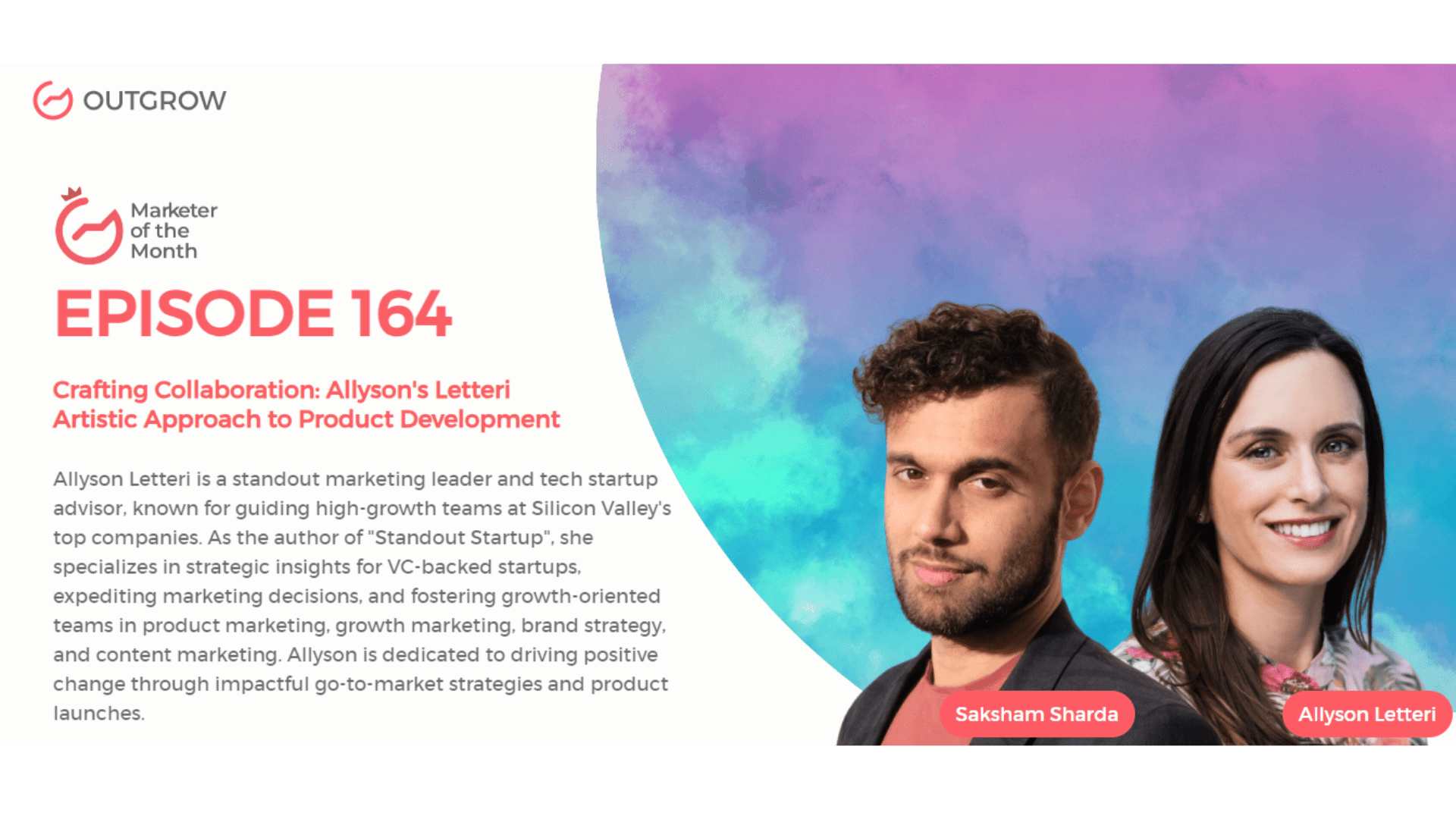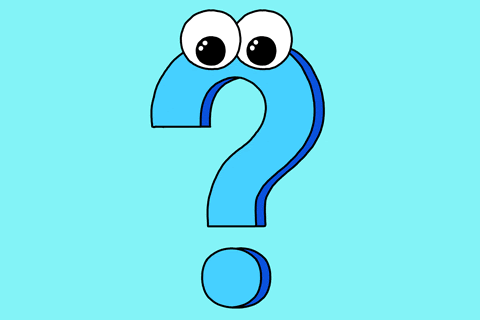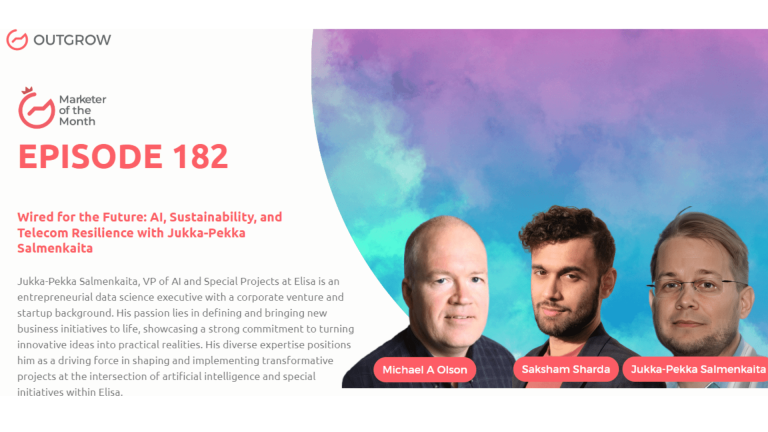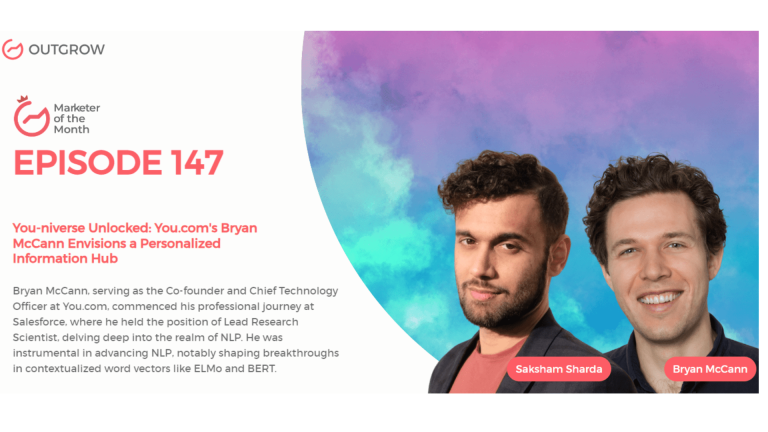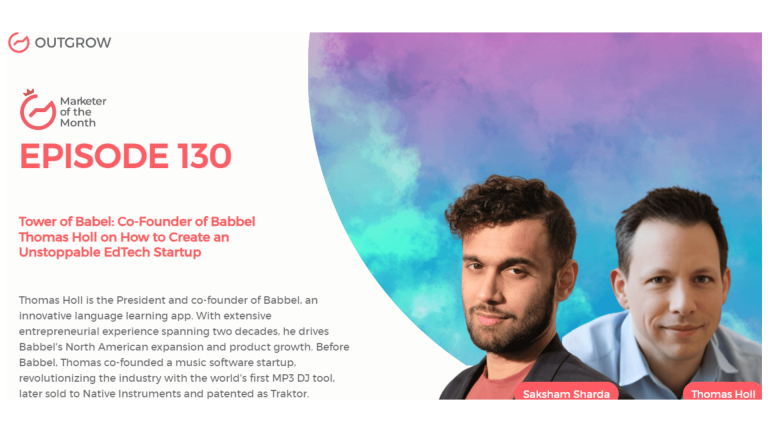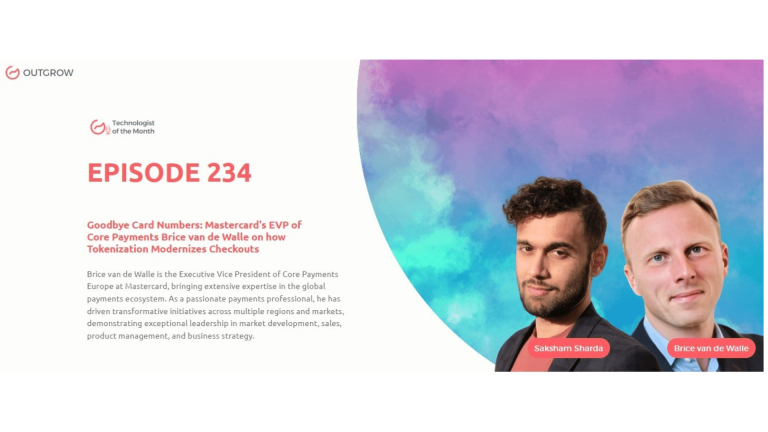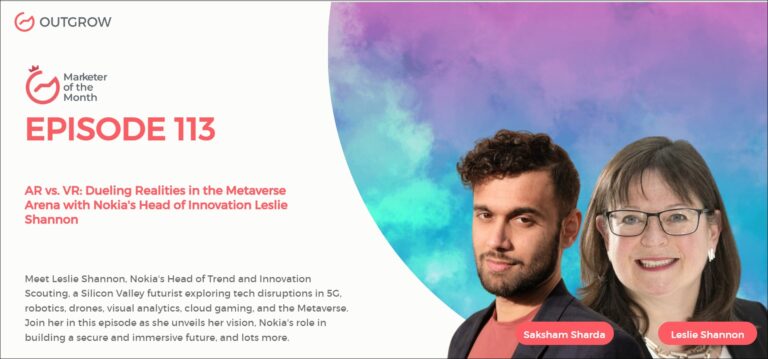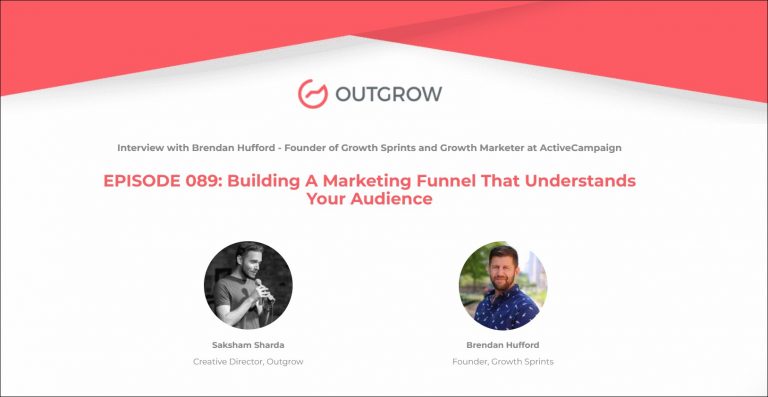EPISODE 164: Marketer of the Month Podcast with Allyson Letteri
Table of Contents
Hey there! Welcome to the Marketer Of The Month blog!
We recently interviewed Allyson Letteri for our monthly podcast – ‘Marketer of the Month’! We had some amazing insightful conversations with Allyson and here’s what we discussed about-
1. Career Transition: From Consulting to Prominent Product Marketing Role.
2. Navigating Marketing Challenges at Thumbtack and Handshake while Building and Scaling High-Performing Marketing Teams.
3. The Crucial Role of Collaboration in Product Development Success.
4. Addressing Startup Challenges: Effective Resource Allocation.
5. Upcoming Book Release: “Standout Startup” – A Guide for Tech Leaders.
6. Product Marketing in Flux: Navigating an Evolving Landscape.
7. Creative Pursuits: Finding Balance through a Passion for Painting.
About our host:
Dr. Saksham Sharda is the Chief Information Officer at Outgrow.co. He specializes in data collection, analysis, filtering, and transfer by means of widgets and applets. Interactive, cultural, and trending widgets designed by him have been featured on TrendHunter, Alibaba, ProductHunt, New York Marketing Association, FactoryBerlin, Digimarcon Silicon Valley, and at The European Affiliate Summit.
About our guest:
Allyson Letteri is a standout marketing leader and tech startup advisor, known for guiding high-growth teams at Silicon Valley’s top companies. As the author of “Standout Startup”, she specializes in strategic insights for VC-backed startups, expediting marketing decisions, and fostering growth-oriented teams in product marketing, growth marketing, brand strategy, and content marketing. Allyson is dedicated to driving positive change through impactful go-to-market strategies and product launches.
Crafting Collaboration: Allyson’s Letteri Artistic Approach to Product Development
The Intro!
Saksham Sharda: Hi, everyone. Welcome to another episode of Outgrow’s Marketer of the Month. I’m your host, Dr. Saksham Sharda, and I’m the creative director at Outgrow. co. And for this month we are going to interview Allyson Letteri, who is the Marketing Leader & Startup Advisor and the Author of ‘Standout Startup’.
Allyson Letteri: Great to be here. Thank you.
Don’t have time to read? No problem, just watch the Podcast!
Or you can just listen to it on Spotify!
The Rapid Fire Round!
Saksham Sharda: So, Allyson, we’re going to start with a rapid-fire round. Just to break the ice, you get three passes. In case you don’t want to answer the question, you can just say pass but try to keep your answers to one word or one sentence only.
Allyson Letteri: Great.
Saksham Sharda: Alright, so the first one is, at what age do you want to retire?
Allyson Letteri: My fifties. But time flexibility is most important to me.
Saksham Sharda: How long does it take you to get ready in the mornings?
Allyson Letteri: 15 minutes. I have to get out the door quickly with the kids.
Saksham Sharda: Most embarrassing moment of your life.
Allyson Letteri: Oh walking into a glass wall at a big party.
Saksham Sharda: Favorite color?
Allyson Letteri: Green.
Saksham Sharda: What time of day are you most inspired?
Allyson Letteri: Mid-Morning, 10:00 AM.
Saksham Sharda: One-word description of your leadership style.
Allyson Letteri: Empowering.
Saksham Sharda: How many hours of sleep can you survive on?
Allyson Letteri: I need at least six.
Saksham Sharda: Fill in the blank. An upcoming marketing trend is ___.
Allyson Letteri: Generative AI to accelerate content creation.
Saksham Sharda: Top priority in your daily schedule?
Allyson Letteri: Self-care, exercise before getting into my work.
Saksham Sharda: The city in which the best kiss of your life happened?
Allyson Letteri: Paris.
Saksham Sharda: Memorable career milestone?
Allyson Letteri: Getting to lead a team for the first time and build it from scratch at Thumbtack.
Saksham Sharda: Pick one. Mark Zuckerberg or Elon Musk.
Allyson Letteri: Zuckerberg.
Saksham Sharda: The biggest mistake of your career?
Allyson Letteri: I underestimated how much my twenties would put me on a specific career path.
Saksham Sharda: How do you relax?
Allyson Letteri: Walks outside.
Saksham Sharda: How many cups of coffee do you drink per day?
Allyson Letteri: Two Non-fat lattes.
Saksham Sharda: A habit of yours that you dislike?
Allyson Letteri: I’m always a few minutes late.
Saksham Sharda: The most valuable skill you’ve learned in life.
Allyson Letteri: Focus on what matters.
Saksham Sharda: And the last one is your favorite Netflix show?
Allyson Letteri: The Diplomat.
Saksham Sharda: The last song you’ve been listening to?
Allyson Letteri: Lots of Taylor Swift this summer.
The Big Questions!
Saksham Sharda: Alright, well that was the end of the rapid-fire round. You scored quite well.
Allyson Letteri: Oh good.
Saksham Sharda: That was great. Is there any question you want to elaborate on in more detail? Any story that comes to mind from any of these answers?
Allyson Letteri: Let’s see. You know, after business school, the question about career mistakes, I don’t think I’ve made a lot of mistakes and that each decision has led to something very interesting. But coming out of business school, I didn’t know I would be a marketer and I didn’t know I would be a product marketer. I’m not sure I knew what that was. And so the first job I took after consulting was at Intuit, and that very quickly shaped the types of experience I got. And I don’t think I realized that that would put me on a tech marketing path. I think I thought I was going to go down a very different path before that. So once you start to get a depth of experience in one area, as you get deeper into your career, it’s a bit harder to backpedal and start something fresh and new. So I’ve loved my path, but I was maybe less intentional about the jobs I took in my mid to late twenties and didn’t anticipate where that would lead me.
Saksham Sharda: So speaking of your career then, it has panned high-growth tech companies in Silicon Valley where you’ve built and led marketing teams. Could you share some key insights or strategies you’ve used to successfully scale marketing teams from scratch in both B2B and B2C settings?
Allyson Letteri: Yes. In every case, it’s so important to start with goals and understand what the company is trying to achieve and what marketing can do to help achieve those goals as quickly as possible. When I started at Thumbtack and Handshake, I came into two different situations, which meant we needed to build out a different type of team and different functions within marketing. So at Handshake, we wanted to reshape perceptions around why Handshake is the unquestionable best place for college students to find jobs and employers to recruit college students. And so we needed to refresh the brand and our messaging to stand out from other career platforms and we needed new ways to acquire employers and students. So there was a lot of acquisition and branding work, whereas at Thumbtack we were doing great on the acquisition front, but for many of our service professionals, Thumbtack is a platform to find local service pros to do a huge range of jobs.
Allyson Letteri: They would get started on the platform, but unless they got hired relatively quickly, they wouldn’t stick around. So the work was really to figure out how to engage our pros more effectively in their first days and weeks on the platform so that they would use us as their main lead gen, main lead generation source for months and years to come. And so thinking about goals and what we needed to build, really informed who I hired and the sequence of some functions that I built out. So that was a big learning. The other thing I’ll say is that when you’re building a team and a fast-growing company, you have to think on different time horizons. So in every case, I walked into a function that didn’t exist. So I had to think about how we get work done now and make progress towards our goals while building towards the bigger team that has all of the capabilities we need. So that often meant doing some of the work myself and hiring agencies or freelancers to get us started but spending quite a bit of my time hiring and building out the MarTech stack and the set of people we needed to achieve the full-funnel marketing strategy down the line. I’ll say for B2B it’s essential that marketing and sales have a strong relationship. And so aligning on what is the go-to-market motion, is this more of an outbound high touch or account-based marketing motion where sales are involved early on and marketing supplies content and messaging to enable sales? Or is it more of an inbound motion where marketing is casting a net with content and trying to attract people in and then qualifying leads for sales? So those conversations go well and sales are only spending their time on companies and people that are more likely to be a great fit for the product that informs wildly different metrics, success metrics, and capabilities to build. So it’s critical to have that discussion and figure that piece out, whereas in B2C it’s more about marketing and product partnership. So it’s often more of a self-service motion: customers will find out about the product and then they’re signing up on their own. So you need to get clear on what the levers marketing can pull to attract onboard and engage customers, but then how can marketing uniquely play and what channels will they test? How can marketing and product work together to make sure that conversion continues to go up along the funnel? And so depending on which type of team you’re building, your focus areas and those partnerships will look different.
Saksham Sharda: So you spoke a lot about hiring people and how a lot of your time was taken up with hiring especially in this economy, there’s been such a turnover of employees coming in and going out. How is a marketing manager supposed to keep track of this and not invest all their time in just hiring?
Allyson Letteri: Well, marketing is so interesting because it spans an incredibly diverse range of roles from some of the most technical and data-driven roles in the company to some of the most creative roles. And so a marketing leader needs to adapt their style to the different functions and the different people that they’re working with at that time. And I’ll say that I’ve learned over my career that thinking of yourself as a manager who’s in service to your team and adapting your style to the needs of that particular person has been critical. So whether it’s a certain type of coaching or focusing on the resources that they need at that time, helping them build the cross-functional relationships that will help them get the job done. I think it requires retaining a team and not spending all your time on hiring. It relies on being a very handy manager and kind of taking yourself out and thinking how can I help this person on my team do their work most effectively and achieve their goals? And so that’s where I’ve always spent a lot of my time and attention.
Saksham Sharda: And so you now advise founders and leaders at VC-backed startups helping them fast-track marketing decisions of all kinds and building growth-focused teams. So could you elaborate on some common marketing challenges that these early-stage startups, stage startups encounter and how your guidance addresses these challenges?
Allyson Letteri: Yes, I see a lot of patterns and one of the most common things that happens in a first conversation with a founder is they’ll say something like, I know I need to be posting on LinkedIn, but that’s very overwhelming. How will I create all that content? Or I need to do more in paid advertising or my SEO strategies are all wrong. It’s very fast-paced. And I think that happens because people without a marketing background often don’t have a framework or a way of thinking about a holistic marketing strategy and then thinking, where does a channel or a particular program fit into that? So one of the first things I do with a founder is helping them think about their marketing strategy along the customer journey. I think of this in five phases. So what are you doing to attract new leads or people into your marketing universe who’ve never heard of your product before? And then the second phase is nurture. Now that you have their attention, what content are you sharing or experiences or demos that help someone see that your product is the best fit for them? It’s different and better than the alternatives. The price is right, it will get them the outcome they want so that ultimately they move to the third phase, which is conversation. And so at that point, they’re becoming a user or they’re becoming a customer. And you shift into the fourth phase, which is onboard. So how do you accelerate time to value and help that new user realize, yes, this is the product for me I wanna keep using. And finally, the fifth phase is engagement. And hopefully, that’s the longest phase of your relationship with this customer, but how do you continue to drive active use? How do you expand accounts? And so once a founder is thinking in those terms, we can do a red, yellow, green exercise. Where is your strategy working today? It’s, you know, shining green, and where is there frank friction? It might be more yellow or red. And then once we know that we can think about what the customer’s needs are at that time. What information do they need to move forward and convert to the next phase? So it’s thinking about the content and the messages that help that person. And then the last step is the channel. Okay, now we know what we need to say to someone, what’s the best way to reach them? And so that shift in thinking guides a lot of how we build out the marketing strategy. And we’re thinking of channel last instead of channel first. The other common thing I see is founders and leaders equating marketing with acquisition or demand generation. So a lot of their thinking is, how do I get new leads in either to qualify them for the sales team or to go through our self-service funnel? While the acquisition is a vital part of marketing strategy, it’s really important to think about the mid-funnel before you go straight to the top of the funnel. So once you have the attention of your ideal customer, where do you land them? What are you offering them? What does your website say that entices them and makes them realize this is the right solution for them? What experiences through either longer-form content or webinars or events are you inviting them into? And then of course, once they do convert, is your onboarding setup effective either with an account manager and more of a sales-led organization or more self-service onboarding? Are you inviting leads into a leaky bucket or is there a very strong chance that they will be successful if they start using the product? So it’s often rethinking mid-funnel and onboarding before pouring energy into paid earned or other channels to attract leads. And then the last one I’ll highlight that’s very common is my messaging is out of whack. My website reflects, you know, version one of my product and now we’re on version five and we just haven’t been able to keep pace or what my sales team is saying to describe our product and what marketing is saying. It’s different. And how do I align these? And so going back to go-to-market basics really and defining your ideal customer, your positioning, how are you different and better, and your brand personality becomes essential so that you can create a messaging framework that aligns the entire team and then you adapt those messages to the different phases of the customer journey. So I have often found that all roads lead back to creating strong messaging before we can build out the rest of the marketing strategy.
Saksham Sharda: But this kind of startup also often faces resource constraints. So what strategies do you recommend to prioritize and allocate limited marketing resources effectively?
Allyson Letteri: That’s such an important question. And I’d say first again, start with the customer journey framework. So get very clear on where you need to make progress in the next three to six months. Where is there the most friction? Where are you soft in your acquisition goals or your retention goals? And decide where to focus because the more fragmented your marketing team is, especially when it’s small and resource-constrained, the less progress you’re likely to make in all of those different buckets. So sometimes that does mean we just need to focus on generating more leads. Our nurturing experience is very strong. Once people land on our website or once they talk to our sales team, they convert. We just don’t have enough people coming into the top of the funnel or sometimes that is we have a great conversion, but we see people dropping out after the first week or month of using the product. So get clear on the phase of the customer journey that you need to focus on. And then again, think about what the customer needs and what content you can create the minimum, most intentional set of content to help someone get to the next step. And then what channels should we be testing to see if we can improve conversion in that phase? So it comes down to ruthless prioritization and being very clear on the metric you need to move now. And then what’s next after that?
Saksham Sharda: So let’s talk a bit about your upcoming book now, it’s called Standout Startup and it focuses on irresistible marketing for startups. Could you provide a sneak peek into some key principles or strategies that startups can use to stand out in the competitive market?
Allyson Letteri: I have proof right here. So my book is called Standout Startup, the Founder’s Guide to Irresistible Marketing that Fuels Growth. I wrote it as a step-by-step guide for early-stage tech startup leaders to develop effective product messaging and high-converting content. And the reason is because as I mentioned, this became the blocker for most marketing strategies. We couldn’t move forward until we defined effective messaging and got clear on how we were describing the product in a way that attracted new customers and engaged and retained existing customers. So some of the examples of questions founders would come to me with would be, you know, peak season is coming up, we have to knock sales out of the park, but I know that our sales deck and our website are not set up to convert or in other cases, something shifts in the market. So, you know, I was talking to a company last week, and a new competitor has come in, has copied their website, and is undercutting them on price. So now it’s challenging for a prospect to compare their product to the other product. And so the book is divided into three parts. The first part is about defining your three Ps which are your persona, your positioning, and your personality. I’ve found that these are the essential ingredients to be able to develop powerful product messaging, your persona or if your B2B, it’s your ICP, your ideal customer profile, so the company that’s the best fit for your product, and then the personas that you’re selling to and trying to convert within the company. You need to understand their current challenges both functional pain points, but also emotional and social pain points. What are the things they’re trying to overcome with a solution? And then you need to understand the outcomes they want to achieve. What’s that desired end state? How do they want to feel? What jobs do they want to have done once they have a product or a solution to solve this problem? And then what motivates them right now to consider solutions and also what’s holding them back. So once you understand this set of things about the person you’re talking to, you can start to describe your product in a way that’s very valuable to them. Talk about how the product will address their needs, emotional and functional. Excuse me. The second piece is positioning. And this is really about, okay, I can now describe my product in a valuable way, but how can I make it stand out from the alternatives? How can we get very clear on what makes our product different and better for that specific ideal customer? And that’s the trick, actually defining the competitive set that that customer considers and making sure your product has an X factor that makes it the clear winner over those other options. So positioning is really about defining your differentiators and then your personality is also a differentiator, but it defines the way you communicate with your ideal customers, your brand attributes, your tone of voice, but also your visual brand identity. And a great personality helps you build a relationship and build affinity with your ideal customer. So if you nail those three Ps you can move into part two, which is creating powerful product messaging. The framework I like to use is what is your unique selling proposition, your USP, which is the headline statement about what your product is, who it’s for, the big promise or outcome that your product delivers, and how it’s different and better. And then the second part is three value prop pillars. So what are the main benefits your product creates for your ideal customer that are differentiated from the cost competition? If a customer remembers these three things about your product, they are very likely to choose you over the alternatives because it will be clear that your product delivers something unique or is a better user experience. And then last but not least, it’s the proof points. How are you backing up the fact that you have claimed that your product can deliver all these great outcomes? And so it’s a mix of the functionality and the user experience that delivers the value, social proof, endorsements, customer stories, and other outside endorsements that can help validate that your product delivers these outcomes. And then finally, data and information that proves that your product can do what you’re saying it does. And for an early-stage startup proof points become even more important because there is a level of risk involved in saying, I’ll go with your product over an entrenched competitor. So I find that’s a place where companies often need to make a lot of progress. And then just to quickly touch on the last part of the book it’s very important to then translate that into a high-converting content strategy. And this is again, where you think along the customer journey, what is the content that customers need at each phase and how can you roll that out in a range of channels so that you are increasing conversion at every step. So overall it is foundational marketing, but it does set founders and startup leaders up for success in creating a robust marketing strategy and nailing down product messaging, which is the backbone of any successful strategy.
Saksham Sharda: So did you go into 4Ps or do we still have 3Ps?
Allyson Letteri: Still, so the three Ps are part one of the book’s persona, positioning, and personality. There are so many Ps in marketing but I’ve found that if you can nail those down, you can define effective messaging and a content strategy that works for your ideal customers.
Saksham Sharda: Are there any examples or case studies that you show in the book that come to mind at this point that demonstrate this in a way?
Allyson Letteri: I have a lot of examples in the book, so please definitely dig into that. There’s one founder that I mentioned who is the CEO of a security platform for an e-commerce company. The reason she started her company was she was finding at past e-commerce companies where she was lead leading engineering, that there was this constant challenge of whether to build a solution in-house or go with an out-of-the-box solution to monitor potential risks or security breaches for our e-commerce platform. And she felt like all of the tech options out there, off-the-shelf options were subpart. So we went through the entire process to figure out who is your ideal customer profile. What are the companies that you’re selling to, but specifically who do you need to influence within that company to make them understand that buying your product is a better option than building in-house? And so in the book, we go through an example where we get into the mindset of an engineering director who’s having to make this decision. They feel underprepared to make this decision. They’re not exactly sure what criteria they should be using to assess security platforms. They feel a lot of vulnerability because they know that if a security breach happens, their career is on the line, and it looks very bad on them. And they also know that their team doesn’t love to do security-related work. They would much rather be building and shipping customer-facing features that make the e-commerce platform stronger. So really getting into the mindset of that engineering director sets this founder up for creating messaging that appeals to that person. And then we also talk about differentiators, but part of the content and messaging strategy is creating content that this engineering director can take back to their CEO to demonstrate why the product is the way it works and the customer success stories make it the perfect fit for their company. And it’s filled with proof points so that the engineering director has a lot to share internally to get the buy-in, they need to drive the purchase.
Saksham Sharda: So you also offer workshops for all this to VVC portfolio leaders to accelerate these marketing outcomes. Could you share some of the most valuable takeaways or strategies covered in these workshops?
Allyson Letteri: Yes. I’m very fortunate to work with a range of venture capital firms in Silicon Valley and beyond. The reason that these workshops are so helpful, is that many times technical founders don’t have a marketing background and they’re faced with making important and expensive marketing decisions and hiring decisions without the knowledge or without knowing what they don’t know. And so my workshops aim to address some of the key questions that come up. They tend to fall into two categories. One is more content and messaging-related, and the second is about building a marketing team. So on the content side, one of the most popular ones goes into creating a core content strategy. This is where rather than creating fragmented channel-by-channel content, I help startup leaders think through what are the key messages they need to get out over the next three to six months. Where in your funnel is there friction? And so you need content to help customers make decisions. And also what’s happening in the macro environment and in your customers’ lives that bring up some timely themes. What are they thinking about in the next few seasons like the holiday season coming up or back to school season had a huge impact on us at Handshake? And so we then think about what are the minimum few, couple pieces of content you can create that move your overall funnel forward that creates some of the evergreen content that your customers need as they’re going from discovering your product to learning more about it and deciding it’s for them. But also what are some of the timely pieces of content you can use to catch attention and potentially pitch to the media or do more seasonal ad campaigns that might hook someone more than just your evergreen messaging? So this core content strategy is an important part of I think a successful early-stage startup marketing strategy. And it’s a great topic for one of the workshops. The other one is to build your startup marketing team. And I developed a framework that I call the Grow framework to help think through the phases of developing the team. Grow stands for G goals, R roles, o org, w watchouts. So as I’ve mentioned, any good marketing decisions around what I build, start with the goals and the goals of the company, whether it’s acquiring more customers, retaining more customers, refreshing our brand, or changing perceptions all inform what roles, which is the R you need to hire for. And I like to think of marketing functions in three main buckets. So first is growth-related roles or demand generation in B2B, these are the more technical marketers, often performance marketers that are accountable for acquiring new customers. So that is one of the types of marketer you’ll likely need on your team. The second is product marketing, and these are the marketers that are responsible for messaging, go-to-market strategy, and launch of new products or features, but often, in many cases customer marketing. So how are you engaging and retaining your current customer base? So that’s the second bucket. And then the third is content marketing, which tends to be an enabler of growth and product marketing but also owns a range of channels like social media, PR, and sometimes SEO. And so really mapping what are the roles we need to, the goals that you established in the first step is an important part of this process. The third is defining your org. So now you have a sense of what roles you need, but who should you hire first and how should you build out the team over time? And I’ve found that many startups go through phases. There’s this pre-marketing phase where the founder is often the first product marketer and the first acquisition marketer. And often hiring a copywriter and a designer can accelerate the founder as they’re creating content. The next step is really to decide who is the first actual marketing hire. And I say, instead of thinking about hiring a generalist, it’s better to think about this first marketing hires major and minor, figuratively. So what are the main skills they need, whether it’s more acquisition, growth, marketing oriented, or more go-to-market messaging and customer marketing oriented? And then yes, you need that first marketer to do a little bit of everything but higher for the capability you need most. And then over time, you’re moving into a flat marketing org where potentially you have a marketing director who’s managing a smaller team where you’ve got just a person or two in each function. And the last stage is a VP or CMO where you have a depth of functions and multiple people in each of those different areas. And one of the mistakes I sometimes see is that startups jump straight to hiring a VP or a CMO and that person’s genius tends to be setting strategy and executing through a team. And so I do see startups get in trouble when they go straight to someone more about team building and strategy setting than someone ready to take on whatever is necessary and do a lot of execution work early on in a startup’s lifecycle. And then lastly, the watchouts. Some really common pitfalls that I see startups getting into are number one, not preparing the cross-functional team for what marketing is and the role it can play. So sales must understand how to partner with marketing in a B2B org. And that product embraces marketing in a B2C org. Also think about the resources your marketer will need, set clear goals, and finally advance. So marketers are very ambitious. There are lots of different ways they can get career growth, but thinking about that ahead of time before you hire can be very helpful when it comes to retention and a thriving happy team.
Saksham Sharda: So given all this extensive experience that you have in product marketing, could you provide some insights into the evolving landscape of product marketing in the tech industry? How has it changed over the years and what trends do you foresee?
Allyson Letteri: Product marketing’s such an important and powerful function. It plays so many different roles. I also think it’s misunderstood in many cases and many of my conversations also start with what is product marketing. What do I need, what does it do? So to highlight I think one of its most important roles, defining your go-to-market strategy is essential and it sets up the rest of the marketing team for success. So the reason I wrote my book about these first steps of the Go-to-market strategy, define your ideal customer, who are you talking to? What messages resonate with them? How are you positioned in the market so that your product stands out from the alternatives? What is your personality? How can you communicate consistently with the entire marketing team? And the entire company needs to understand those things. So empowering product marketing to lead the process to make those decisions, but also involving a very cross-functional team in those decisions is essential. And so I find that when sales and product leaders and certainly the CEO or founder are involved in setting that go-to-market strategy, the rest of marketing can be much more effective and so can sales and product because everyone’s aligned on what are we standing for in the market and what’s the roadmap we’ll use to get there and what are the messages we’ll create to make sure customers understand that about us. So going to the market is an essential piece. The second thing that I have learned is that the more marketing and product can be working together on every stage of the product development process, the better outcomes a team will get. And what I mean by that is sometimes marketing is brought in at the last minute to launch a feature or launch a product. The product team is agile, they’re releasing features as they see things working and they pull products in at the last minute or full marketing at the last minute. But if marketing can have a seat at the table in the planning cycle, think through what are the unmet needs of our customers. Product marketing does a great job at finding customer insights, synthesizing what sales is saying, and bringing that information to the product and the dev team. And then deciding to build features that both advance our positioning. So, how can we look and be stronger in the market, but also address these unmet needs that are so important? And then marketing can be involved in launching the beta and the tests where the product team is validating whether these features work and whether they want to take them to general availability. And when marketing is involved in that stage, they’re getting lots of user feedback and they’re hearing directly from customers about what’s working, what’s not working, and they’re testing messages so that when it comes time for the launch, marketing’s very clear on the value of this product, they’re able to work it into their messaging framework and their content. Generally, the launch is more successful and the product and marketing feel more aligned. So I would like for that to be a trend and I do see more success when that happens. And then the last thing I’ll say about product marketing. So especially in times like we’re facing right now where there’s the shift to profitability away from growth at all costs, top-of-funnel marketing spend is being cut, and there is a bigger role for customer marketing. So how can product marketing and customer marketing and product marketing be very interrelated? How can we retain more customers through marketing levers? And so I see that product marketing plays an even bigger role in times like this. You know, how can we launch effective lifecycle marketing programs where behavioral-based or time-based reminders nudge customers to take a certain action? How can we create seasonal campaigns to create energy around a specific moment? So as an example, the Handshake Back to School season was very important and very engaging to employers and students. Employers were eager to hear about our latest features and any of the latest tips on how to recruit the best possible class for their next internship class. Or their next first-year hires class and students were coming back to campus knowing that they needed to get their act together and start the internship search process. And so they were open to hearing, okay, which platform is best for me and how do I use handshake most effectively? So seasonal campaigns around these peak moments became very important to engaging existing customers. And then finally feature launches over time, you will be delivering more and more value as you roll out new features on your roadmap. So product marketing plays a very important role in making sure your current customers understand that and in B2B partnering with account managers to make sure that your customer base sees the value of new features, starts to use them, rolls them out to their team and ultimately decides to stick with and expand your product. So that role of customer marketing I think is becoming ever stronger and it’s so important and I love that about product marketing.
Saksham Sharda: And so the last question for you is of a personal kind. What would you be doing in your life, if not this right now?
Allyson Letteri: I have always been very creative and so I partly gotta scratch that itch with writing the book. But I’m also a painter so I have had periods of my life where I spend a lot of time painting. Did a lot of that a couple of years ago. So probably being a watercolor or acrylic painter of mostly nature.
Let’s Conclude!
Saksham Sharda: Thanks, everyone for joining us for this month’s episode of Outgrow’s Marketer of the Month. That was Allyson Letteri, who is the Marketing Leader & Startup Advisor and the Author of ‘Standout Startup’.
Allyson Letteri: Great to be here. Thank you.
Saksham Sharda: Check out the website for more details and we’ll see you once again next month with another marketer of the month.

Muskan is a Marketing Analyst at Outgrow. She is working on multiple areas of marketing. On her days off though, she loves exploring new cafes, drinking coffee, and catching up with friends.

